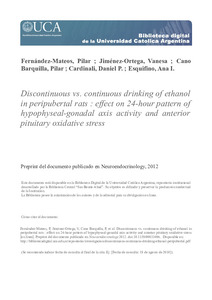Por favor, use este identificador para citar o enlazar este ítem:
https://repositorio.uca.edu.ar/handle/123456789/1662| Título: | Discontinuous vs. continuous drinking of ethanol in peripubertal rats : effect on 24-hour pattern of hypophyseal-gonadal axis activity and anterior pituitary oxidative stress | Autor: | Fernández Mateos, María P. Jiménez Ortega, Vanesa Cano Barquilla, Pilar Cardinali, Daniel Pedro Esquifino, Ana I. |
Palabras clave: | ALCOHOLISMO; REPRODUCCION HUMANA; PROLACTINA; LIBIDO; STRESS; RITMO CIRCADIANO | Fecha de publicación: | 2012 | Editorial: | Karger Publishers | Cita: | Fernández-Mateos, P, et al. Discontinuous vs. continuous drinking of ethanol in peripubertal rats : effect on 24-hour pattern of hypophyseal-gonadal axis activity and anterior pituitary oxidative stress [en línea]. Preprint del documento publicado en Neuroendocrinology 2012, 96. doi:10.1159/00033496. Disponible en: https://repositorio.uca.edu.ar/handle/123456789/1662 | Resumen: | Abstract: Aims. Discontinuous (weekend) consumption of alcohol is common in adolescents and young adults. This study therefore assesses, in peripubertal male rats, the effect of discontinuous as compared to chronic feeding of ethanol or control liquid diet. Methods. Animals received an ethanol liquid diet (6.2 % wt/vol) starting on day 35 of life. Every week for 5 weeks, the discontinuous ethanol group received the ethanol diet for 3 consecutive days and the control liquid diet for 4 days. At the 5th week, 24 h after the last ethanol administration to the discontinuous ethanol treated animals, rats were killed at 4 h intervals beginning at 0900 h. Chronically administered rats received the ethanol diet until immediately before study. Results. Disrupted 24-h rhythmicity together with a significant nocturnal increase in plasma luteinizing hormone (LH), testosterone and prolactin (PRL) occurred in the discontinuous ethanol group. Plasma ethanol levels were undetectable at 24 h after the last ethanol treatment. In contrast, after chronic ethanol administration, plasma PRL was increased late in scotophase while LH and testosterone decreased; blood ethanol levels were 2-fold greater than those in discontinuously ethanoladministered rats killed immediately after ethanol withdrawal. Circulating testosterone positively correlated with LH levels in control rats only. Chronic administration of ethanol significantly augmented mean expression of pituitary nitric oxide synthase (NOS)-2, heme oxygenase (HO)-1, Per1 and Per2 genes and disrupted their diurnal rhythmicity. Decreased NOS-1 and NOS-2 expression during scotophase, together with suppression of the rhythm in Per1 and Per2 expression, were found in the discontinuous ethanol group. Conclusions. Abstinence after discontinuous drinking of alcohol in rats, as compared to chronic administration of ethanol, is accompanied by increases of plasma LH and testosterone, a greater PRL response and a less pronounced oxidative damage of the anterior pituitary. | URI: | https://repositorio.uca.edu.ar/handle/123456789/1662 | Disciplina: | MEDICINA | DOI: | 10.1159/000334963 | Derechos: | Acceso Abierto | Fuente: | Neuroendocrinology. 2012, 96 |
| Aparece en las colecciones: | Artículos |
Ficheros en este ítem:
| Fichero | Descripción | Tamaño | Formato | |
|---|---|---|---|---|
| discontinuous-continuous-drinking-ethanol-peripubertal.pdf | 588,3 kB | Adobe PDF |  Visualizar/Abrir |
Visualizaciones de página(s)
220
comprobado en 30-abr-2024
Descarga(s)
245
comprobado en 30-abr-2024
Google ScholarTM
Ver en Google Scholar
Altmetric
Altmetric
Este ítem está sujeto a una Licencia Creative Commons

